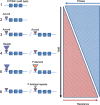Transposable elements and xenobiotic resistance
- PMID: 38469483
- PMCID: PMC10926513
- DOI: 10.3389/finsc.2023.1178212
Transposable elements and xenobiotic resistance
Abstract
Transposable elements or TEs are well known drivers of adaptive change in plants and animals but their role in insecticide resistance remains poorly documented. This review examines the potential role of transposons in resistance and identifies key areas where our understanding remains unclear. Despite well-known model systems such as upregulation of Drosophila Cyp6g1, many putative examples lack functional validation. The potential types of transposon-associated changes that could lead to resistance are reviewed, including changes in up-regulation, message stability, loss of function and alternative splicing. Where potential mechanisms appear absent from the resistance literature examples are drawn from other areas of biology. Finally, ways are suggested in which transgenic expression could be used to validate the biological significance of TE insertion. In the absence of such functional expression studies many examples of the association of TEs and resistance genes therefore remain as correlations.
Keywords: insect; insecticide; resistance; transposable element; transposon.
Copyright © 2023 ffrench-Constant.
Conflict of interest statement
The author declares that the research was conducted in the absence of any commercial or financial relationships that could be construed as a potential conflict of interest.
Figures



References
Publication types
LinkOut - more resources
Full Text Sources
Molecular Biology Databases

